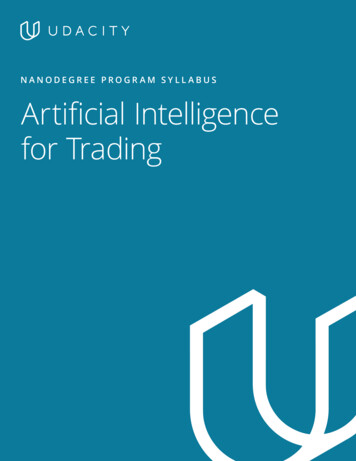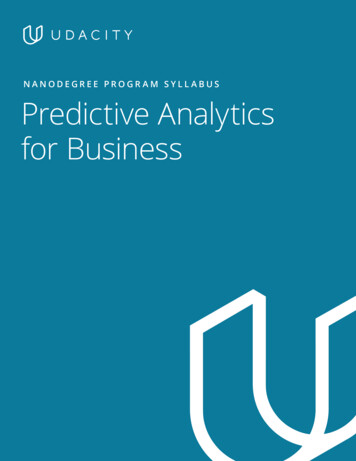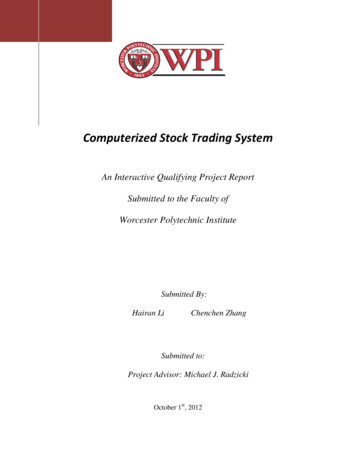
Transcription
NANODEGREE PROGR AM SYLL ABUSArtificial Intelligencefor Trading
OverviewIn this program, you’ll analyze real data and build financial models for trading. Whether you want to pursue anew job in finance, launch yourself on the path to a quant trading career, or master the latest AI applicationsin quantitative finance, this program offers you the opportunity to master valuable data and AI skills.I N CO L L A B O R AT I O N W I T HEstimated Time:6 Months at10hrs/weekPrerequisites:Python &MathematicsFlexible Learning:Self-paced, soyou can learn onthe schedule thatworks best for youTechnical MentorSupport:Our knowledgeablementors guide yourlearning and arefocused on answeringyour questions,motivating you andkeeping you on trackArtificial Intelligence for Trading 2
Course 1: Basic Quantitative TradingIn this course, you will learn about market mechanics and how to generate signals with stocks. Your firstproject is to develop a momentum trading strategy.Course Project : Tradingwith MomentumIn this project, you will learn to implement a momentum tradingstrategy and test if it has the potential to be profitable. You will workwith historical data of a given stock universe and generate a tradingsignal based on a momentum indicator. You will then compute thesignal and produce projected returns. Finally, you will perform astatistical test to conclude if there is alpha in the signal.LEARNING OUTCOMESLESSON ONEIntroductionLESSON TWOStock PricesLESSON THREEMarket MechanicsLESSON FOURData ProcessingLESSON FIVEStock ReturnsLESSON SIXMomentum TradingArtificial Intelligence for Trading 3
Course 2: Advanced Quantitative TradingIn this course, you will get to know the workflow that a quant follows for signal generation, and also learnto apply advanced quantitative methods in trading.In this project, you will code and evaluate a breakout signal. You willrun statistical tests to test for normality and to find alpha. You willalso learn to find outliers and evaluate the effect that filtered outlierscould have on your trading signal. You will run various scenarios ofyour model with or without the outliers and decide if the outliersshould be kept or not.Course Project:Breakout StrategyLEARNING OUTCOMESLESSON ONEQuant WorkflowLESSON TWOOutliers and Filtering SignalsLESSON THREERegressionLESSON FOURTime Series ModelingLESSON FIVEVolatilityLESSON SIXPairs Trading and Mean ReversionArtificial Intelligence for Trading 4
Course 3: Stocks, Indices, and ETFsIn this course, you will learn about portfolio optimization, and financial securities formed by stocks such asmarket indices, vanilla ETFs, and Smart Beta ETFs.In this project, you will create two portfolios utilizing smart betamethodology and optimization. You will evaluate the performanceof the portfolios by calculating tracking errors. You will also calculatethe turnover of your portfolio and find the best timing to rebalance.You will come up with the portfolio weights by analyzing fundamentaldata, and by quadratic programming.Course Project:Smart Beta and PortfolioOptimizationLEARNING OUTCOMESLESSON ONEStocks, Indices and FundsLESSON TWOETFsLESSON THREEPortfolio Risk and ReturnLESSON FOURPortfolio OptimizationArtificial Intelligence for Trading 5
Course 4: Factor Investing and Alpha ResearchIn this course, you will learn about alpha factors and risk factors, and construct a portfolio with advancedportfolio optimization techniques.Course Project:Multi-factor ModelIn this project, you will research and generate multiple alpha factors.Then you will apply various techniques to evaluate the performanceof your alpha factors and learn to pick the best ones for yourportfolio. You will formulate an advanced portfolio optimizationproblem by working with constraints such as risk models, leverage,market neutrality and limits on factor exposuresLEARNING OUTCOMESLESSON ONEFactors Models of ReturnsLESSON TWORisk Factor ModelsLESSON THREEAlpha FactorsLESSON FOURAdvanced Portfolio Optimization with Risk and Alpha Factors ModelsArtificial Intelligence for Trading 6
Course 5: Sentiment Analysis with NaturalLanguage ProcessingIn this course, you will learn the fundamentals of text processing and use them to analyze corporate filingsand generate sentiment-based trading signals.Course Project:Sentiment Analysis usingNLPIn this project, you will apply Natural Language Processing oncorporate filings, such as 10Q and 10K statements, from cleaningdata and text processing, to feature extraction and modeling. Youwill utilize bag-of-words and TF-IDF to generate company-specificsentiments. Based on the sentiments, you will decide which companyto invest in, and the optimal time to buy or sell.LEARNING OUTCOMESLESSON ONEIntro to Natural Language ProcessingLESSON TWOText ProcessingLESSON THREEFeature ExtractionLESSON FOURFinancial StatementsLESSON FIVEBasic NLP AnalysisArtificial Intelligence for Trading 7
Course 6: Advanced Natural LanguageProcessing with Deep LearningIn this course, you will get to know how deep learning is applied in quantitative analysis and get to useRecurrent Neural Networks (RNN) and Long Short-Term Memory Networks (LSTM) to generate trading signalsCourse Project:Sentiment Analysis withNeural NetworksIn this project, you will build deep neural networks to processand interpret news data. You will also play with different ways ofembedding words into vectors. You will construct and train LSTMnetworks for sentiment classification. You will run backtests andapply the models to news data for signal generation.LEARNING OUTCOMESLESSON ONEIntroduction to Neural NetworksLESSON TWOTraining Neural NetworksLESSON THREEDeep Learning with PyTorchLESSON FOURRecurrent Neural NetworksLESSON FIVEEmbeddings & Word2VecLESSON SIXSentiment Prediction RNNArtificial Intelligence for Trading 8
Course 7: Combining Multiple SignalsIn this course, you will learn about advanced techniques to select and combine the factors that you’vegenerated from both alternative data and market data.Course Project:Combining Signals forEnhanced AlphaIn this project, you’ll combine signals on a random forest forenhanced alpha. While implementing this, you’ll have to solve theproblem of overlapping samples. For the dataset, we’ll be using theend of day from Quotemedia and sector data from Sharadar.LEARNING OUTCOMESLESSON ONEOverviewLESSON TWODecision TreesLESSON THREEModel Testing and EvaluationLESSON FOURRandom ForestsLESSON FIVEFeature EngineeringLESSON SIXOverlapping LabelsLESSON SEVENFeature ImportanceArtificial Intelligence for Trading 9
Course 8: Simulating Trades with Historical DataIn this project, you will build a fairly realistic backtester that uses the Barra data. The backtester will performportfolio optimization that includes transaction costs, and you’ll implement it with computational efficiencyin mind, to allow for a reasonably fast backtest. You’ll also use performance attribution to identify the majordrivers of your portfolio’s profit-and-loss (PnL). You will have the option to modify and customize thebacktest as well.In this project, you’ll combine signals on a random forest forenhanced alpha. While implementing this, you’ll have to solve theproblem of overlapping samples. For the dataset, we’ll be using theend of day from Quotemedia and sector data from Sharadar.Course Project:BacktestingLEARNING OUTCOMESLESSON ONEIntro to BacktestingLESSON TWOOptimization with Transaction CostsLESSON THREEAttributionArtificial Intelligence for Trading 10
Our Classroom ExperienceREAL-WORLD PROJECTSBuild your skills through industry-relevant projects. Getpersonalized feedback from our network of 900 projectreviewers. Our simple interface makes it easy to submityour projects as often as you need and receive unlimitedfeedback on your work.KNOWLEDGEFind answers to your questions with Knowledge, ourproprietary wiki. Search questions asked by other students,connect with technical mentors, and discover in real-timehow to solve the challenges that you encounter.WORKSPACESSee your code in action. Check the output and quality ofyour code by running them on workspaces that are a partof our classroom.QUIZZESCheck your understanding of concepts learned in theprogram by answering simple and auto-graded quizzes.Easily go back to the lessons to brush up on conceptsanytime you get an answer wrong.CUSTOM STUDY PLANSCreate a custom study plan to suit your personal needsand use this plan to keep track of your progress towardyour goal.PROGRESS TRACKERStay on track to complete your Nanodegree program withuseful milestone reminders.Artificial Intelligence for Trading 11
Learn with the BestCindy LinC U R R I C U LU M L E A DArpan ChakrabortyI N S T R U C TO RCindy is a quantitative analyst withexperience working for financialinstitutions such as Bank of AmericaMerrill Lynch, Morgan Stanley, andPing An Securities. She has an MS inComputational Finance from CarnegieMellon University.Arpan is a computer scientist with a PhDfrom North Carolina State University. Heteaches at Georgia Tech (within the Masters in Computer Science program), andis a coauthor of the book Practical GraphMining with R.Elizabeth Otto HamelEddy ShyuI N S T R U C TO RI N S T R U C TO RElizabeth received her PhD in AppliedPhysics from Stanford University, whereshe used optical and analytical techniquesto study activity patterns of largeensembles of neurons. She formerly taughtdata science at The Data Incubator.Eddy has worked at BlackRock, ThomsonReuters, and Morgan Stanley, and hasan MS in Financial Engineering from HECLausanne. Eddy taught data analytics at UCBerkeley and contributed to Udacity’s SelfDriving Car program.Artificial Intelligence for Trading 12
Learn with the BestBrok BucholtzI N S T R U C TO RParnian BarekatainI N S T R U C TO RBrok has a background of over five yearsof software engineering experience fromcompanies like Optimal Blue. Brok hasbuilt Udacity projects for the Self DrivingCar, Deep Learning, and AI Nanodegreeprograms.Parnian is a self-taught AI programmerand researcher. Previously, she internedat OpenAI on multi-agent ReinforcementLearning and organized the first OpenAIhackathon. She also runs a ShannonLabsfellowship to support the next generationof independent researchers.Juan DelgadoLuis SerranoCO N T E N T D E V E LO P E RI N S T R U C TO RJuan is a computational physicist with aMasters in Astronomy. He is finishing hisPhD in Biophysics. He previously worked atNASA developing space instruments andwriting software to analyze large amountsof scientific data using machine learningtechniques.Luis was formerly a Machine LearningEngineer at Google. He holds a PhD inmathematics from the University ofMichigan, and a Postdoctoral Fellowshipat the University of Quebec at Montreal.Artificial Intelligence for Trading 13
Learn with the BestCezanne CamachoMat LeonardCO U R S E D E V E LO P E RI N S T R U C TO RCezanne is an expert in computer visionwith an M.S. in Electrical Engineering fromStanford University. Inspired by anyonewith the drive and imagination to learnsomething new, she aims to create moreinclusive and effective STEM education.Mat is a former physicist, researchneuroscientist, and data scientist. He didhis PhD and Postdoctoral Fellowship atthe University of California, Berkeley.Artificial Intelligence for Trading 14
All Our Nanodegree Programs Include:EXPERIENCED PROJECT REVIEWERSREVIEWER SERVICES Personalized feedback & line by line code reviews 1600 Reviewers with a 4.85/5 average rating 3 hour average project review turnaround time Unlimited submissions and feedback loops Practical tips and industry best practices Additional suggested resources to improveTECHNICAL MENTOR SUPPORTMENTORSHIP SERVICES Questions answered quickly by our team oftechnical mentors 1000 Mentors with a 4.7/5 average rating Support for all your technical questionsPERSONAL CAREER SERVICESC AREER SUPPORT Github portfolio review LinkedIn profile optimizationArtificial Intelligence for Trading 15
Frequently Asked QuestionsPROGR AM OVERVIE WWHY SHOULD I ENROLL?Demand for quantitative talent is growing at incredible rates. Data-driventraders are now responsible for more than 30% of all US stock trades byinvestors (or about 1 trillion USD worth of investments, up from 14% in 2013).This scenario represents incredible opportunity for individuals eager to applycutting-edge technologies to trading and finance.Whether you want to pursue a new job in finance, launch yourself on the pathto a quant trading career, or master the latest AI applications in trading andquantitative finance, this program will give you the opportunity to build animpressive portfolio of real-world projects. You will build financial models onreal data, and work on your own trading strategies using natural languageprocessing, recurrent neural networks, and random forests. You’ll also enjoydirect access to leading experts in the field, and get personalized project andcareer support.To create the curriculum for this program, we collaborated with WorldQuant,a global quantitative asset management firm, as well as top industryprofessionals with prior experience at JPMorgan, Morgan Stanley, MillenniumManagement, and more. If your goal is to learn from the leaders in the field,and to master the most valuable and in-demand skills, this program is an idealchoice for you.WHAT JOBS WILL THIS PROGRAM PREPARE ME FOR?Graduates of this program will have the quantitative skills needed to beextremely valuable across many functions, and in many roles at hedge funds,investment banks, and FinTech startups.Specific roles include: Quantitative analyst Quantitative researcher Investment analyst Data intelligence analyst Risk analyst Desk quant Desk strategist Financial engineer Financial data scientistHOW DO I KNOW IF THIS PROGRAM IS RIGHT FOR ME?If you’re a programmer, data analyst or someone with a strong quantitativebackground, this program offers you the ideal path to pursue a quant tradingArtificial Intelligence for Trading 16
FAQs Continuedcareer and prepares you to seek out data science jobs across the financialecosystem.ENROLLMENT AND ADMISSIONDO I NEED TO APPLY? WHAT ARE THE ADMISSION CRITERIA?No. This Nanodegree program accepts all applicants regardless of experienceand specific background.WHAT ARE THE PREREQUISITES FOR ENROLLMENT?The Artificial Intelligence for Trading Nanodegree program is designed forstudents with intermediate experience programming with Python and familiaritywith statistics, linear algebra and calculus. In order to successfully complete thisprogram, you should meet the following prerequisites:Python programming Basic data structures Basic NumpyStatistics Mean, median, mode Variance, standard deviation Random variables, independence Distributions, normal distribution T-test, p-value, statistical significanceCalculus and linear algebra Integrals and derivatives Linear combination, independence Matrix operations Eigenvectors, eigenvaluesIF I DO NOT MEET THE REQUIREMENTS TO ENROLL, WHAT SHOULD I DO?We have a number of short free courses that can help you prepare, including: Intro to Data Analysis Intro to Statistics Linear AlgebraTUITION AND TERM OF PROGR AMHOW IS THIS NANODEGREE PROGRAM STRUCTURED?The Artificial Intelligence for Trading Nanodegree program is comprised ofcontent and curriculum to support eight (8) projects. We estimate that studentscan complete the program in six (6) months working 10 hours per week.Artificial Intelligence for Trading 17
FAQs ContinuedEach project will be reviewed by the Udacity reviewer network. Feedback will beprovided and if you do not pass the project, you will be asked to resubmit theproject until it passes.project until it passes.HOW LONG IS THIS NANODEGREE PROGRAM?Access to this Nanodegree program runs for the length of time specified inthe payment card above. If you do not graduate within that time period, youwill continue learning with month to month payments. See the Terms of Useand FAQs for other policies regarding the terms of access to our Nanodegreeprograms.SOF T WARE AND HARDWAREWHAT SOFTWARE AND VERSIONS WILL I NEED IN THIS PROGRAM?To successfully complete this Nanodegree program, you’ll need to be able todownload and run Python 3.7.Artificial Intelligence for Trading 18
project is to develop a momentum trading strategy. Course Project: Trading with Momentum In this project, you will learn to implement a momentum trading strategy and test if it has the potential to be profitable. You will work with historical data of a given stock universe and generate a trading signal based on a momentum indicator.










